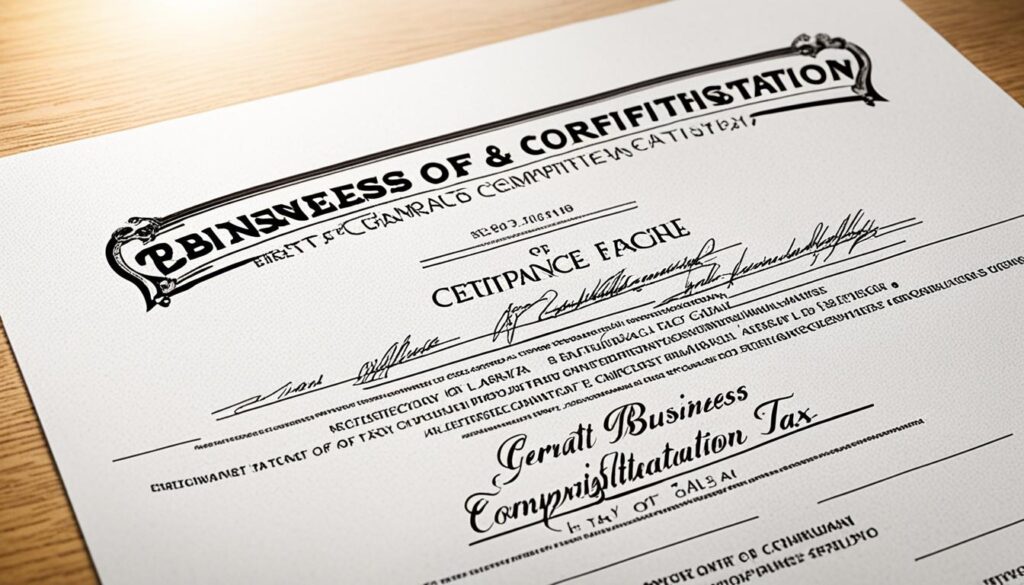Are you ready to tackle business tax preparation? If you’re running a small enterprise, knowing how to handle tax deductions, credits, and requirements is key. This knowledge ensures you stay legal and save money. But the question is, where do you begin?
This detailed guide offers insights, tips, and advice to simplify your business tax filing. Whether it’s picking the best tax structure or keeping track of paperwork, we have you covered. Learn about deadlines and ways to get the most deductions.

Key Takeaways:
- Understand the various aspects of preparing and filing your business taxes
- Choose the right business structure for tax planning purposes
- Learn about the tax considerations for sole proprietorships, general partnerships, corporations, limited liability companies, limited partnerships, and limited liability partnerships
- Master the art of collecting and organizing business records for tax purposes
- Discover tips and guidelines for filing your business taxes and maximizing deductions
Choosing the Right Business Structure for Tax Purposes
When you start a business, picking the right structure is key. The choice affects your legal risks and taxes. It is essential to know about different business structures and how they influence taxes.
Different business structures you may consider are:
- Sole Proprietorship: This is the simplest business form, run by one person. The owner reports business income on their personal tax return. It’s easy to set up but puts personal assets at risk for business debts.
- General Partnership: This involves two or more people sharing the business. Each partner pays taxes on their share of income. It’s simple but personal assets might be at risk.
- Corporation: A corporation is a separate legal body with shareholders. It protects personal assets from debts. Corporations pay taxes differently, including dividends, which are taxed twice.
- Limited Liability Company (LLC): An LLC offers tax benefits and protects personal assets. Owners report income on personal taxes. LLCs are more flexible and have less strict rules than corporations.
- Limited Partnership: It has general and limited partners. General partners run the business, while limited ones invest. General partners pay taxes on their income. Limited partners get liability protection.
- Limited Liability Partnership (LLP): In an LLP, partners have less personal risk. It’s preferred by professionals like lawyers. Partners pay taxes on their income from the LLP.
“Selecting the best business structure is criticial for tax planning. Each option has pros and cons. Consider your business’s needs, growth, and risks when choosing.”
Remember, taxes aren’t the only thing to think about when choosing a business structure. Also consider legal risks, how you want to operate, and your future goals. It’s wise to talk to a tax expert or lawyer. They can help pick the best structure for you.
Comparison of Business Structures for Tax Purposes
| Business Structure | Tax Implications | Liability Protection | Management |
|---|---|---|---|
| Sole Proprietorship | Reported on owner’s personal tax return | No limited liability protection | Owner manages the business |
| General Partnership | Partners report income on their personal tax returns | No limited liability protection | Partners jointly manage the business |
| Corporation | Corporate taxes and potential dividend distribution | Limited liability protection for shareholders | Board of directors manages the corporation |
| Limited Liability Company (LLC) | Reported on members’ personal tax returns | Limited liability protection for members | Flexible management structure |
| Limited Partnership | General partners report income on personal tax returns | Limited liability for limited partners | General partners manage the business |
| Limited Liability Partnership (LLP) | Partners report income on personal tax returns | Limited liability protection for partners | Partners manage the partnership |
Sole Proprietorship: Simplicity and Tax Considerations
A sole proprietorship is easy and the most common way to start a business. As one person, you run the business without setting up a separate business entity. You call the shots in your business but also face all the risks alone. Let’s look into the tax parts of running a business this way.
To use a name different from your last name, you need an assumed name certificate or doing business as (DBA). This certificate is crucial. It tells everyone that you are the person behind the business name. It’s key for your business’s legal side and its public face.
“Operating under an assumed name lets you stand out as a business. It draws people in and builds trust. Just make sure you do the paperwork and follow local rules.”
Choosing the right spot for your business matters a lot. It could be a shop, an office, or your house, if that works. But always check that your place fits local rules about where businesses can be.
Benefits of Sole Proprietorship
Running your own business like this has big pluses. It’s straightforward to start and keep going. You make all the key decisions without dealing with layers of rules. Plus, all the money the business makes is yours to keep.
Tax-wise, sole proprietors have good things going for them. Your business’s money is seen as your money for taxes. You report what you earn and spend on your own tax form. This makes taxes simpler and no need for a separate business tax form.
Tax Considerations for Sole Proprietorship
Tax benefits are great, but know the specifics to make the most of them. Here are key points:
- You’ll pay self-employment taxes, covering Social Security and Medicare, based on your business’s profit.
- Without a regular employer, you need to figure your taxes and pay them four times a year to the IRS to avoid fines.
- Keep detailed records of all business costs. You can subtract many of them from your taxable income, like office supplies and travel costs.
Understanding your tax duties helps you keep your business finances healthy.

| Tax Considerations | Details |
|---|---|
| Assumed Name Certificate (DBA) | Required if operating under a name different from your own surname |
| Business Premise | Find the right place for your business |
| Self-Employment Taxes | Pay into Social Security and Medicare from your business earnings |
| Quarterly Estimated Taxes | Plan and pay your taxes four times a year |
| Business Deductions | Track expenses that can lower your taxable income |
A general partnership is when two or more people start a business together. They get to share profits and responsibilities. But, they must think about taxes and have the right legal papers.
The partnership agreement is a key document. It talks about what each partner can do and how money is shared. This makes things clear and prevents future problems.
If the partnership uses a different name, they need a “Doing Business As” (DBA) certificate. This certificate is important for following the law and identifying the business.
Choosing where to run the partnership matters for taxes. Different places have different tax rules. Partners need to understand these tax rules and follow them.
“A general partnership lets people make decisions together and share resources. But, having a partnership agreement and following legal steps is important.”
Tax Implications of General Partnerships
A general partnership doesn’t pay taxes itself. Instead, profits and losses go to the partners. They put this on their personal tax returns.
Partners must pay taxes on their share of the profits. This includes Social Security and Medicare taxes. It’s like being both the employer and employee.
Partners can also cut down their taxes with deductions for business expenses. These can be things like rent, utilities, and travel costs.
Keeping good records of business transactions is vital. This helps with taxes and making the most of deductions. Accurate bookkeeping is key.

| Tax Considerations for General Partnerships | Key Points |
|---|---|
| Partnership Agreement | A legal document that outlines the rights and responsibilities of each partner, as well as the distribution of profits and losses. |
| Assumed Name Certificate (DBA) | Required if the partnership operates under a name other than the surnames of the partners. |
| Business Premises | The location from which the partnership operates may have tax implications. |
| Tax Implications | A general partnership is a pass-through entity, with profits and losses being reported on the partners’ personal tax returns. |
| Tax Deductions | Partners may be eligible for various deductions related to their business expenses. |
Corporation: Limiting Liability and Managing Taxes
A corporation is a legal setup. It protects the personal wealth of those who own shares against business losses. This separation minimizes your risk financially. Also, it opens doors to various tax benefits.
To start a corporation, you need a certificate of formation. This paper, also called articles of incorporation, lists essential details. These include the company’s name and purpose. You must file it with a state agency.
Once formed, the board of directors guides the corporation. They make big decisions and choose officers. Their main aim is to look after the corporation and its investors’ interests.
Shareholders are people or groups owning company parts. They can vote on big decisions and pick the board. When the company earns, they may get a share of the profits.

Sometimes, a corporation might choose to be an S corporation. This choice allows them to be taxed like a partnership. It means profits and losses directly affect the shareholders’ taxes. This helps avoid being taxed twice.
Handling a corporation’s taxes needs careful strategy. Working with a tax expert or a CPA is wise. They can help you follow the tax rules and save money.
Limited Liability Company: Flexibility and Liability Protection
An LLC blends perks from corporations and partnerships. It’s flexible in management and protects members’ liability. Let’s look into making an LLC, member roles, and management options.
The Formation Process
To start an LLC, file a certificate of formation with the state. This paper confirms your LLC’s existence. It lists the name, address, agent, and how it’s run.

With the certificate filed, your LLC is set. You get protection and benefits. Ensure you meet your state’s requirements for a smooth setup.
Roles of Members
An LLC can have different owners: people, corporations, or other LLCs. They decide on big issues and often run daily activities.
LLC members aren’t usually liable for debts beyond their investment. This keeps their personal property safe from business troubles.
Choosing a Management Structure
An LLC’s management can vary. You can choose between being member-run or manager-run.
Member-managed: Here, all members partake in decisions and operations. This fits smaller teams well.
Manager-managed: In this setup, members pick managers for daily tasks. It’s good when members prefer less active roles or have varied skills.
Pick a structure that matches your business size, needs, and member involvement.
Tax Benefits
An LLC has pass-through taxation. The LLC doesn’t pay federal income taxes. Instead, members declare profits and losses on their personal taxes.
This system avoids the double taxation corporations face. It simplifies tax filing and can save members money.
Starting an LLC offers liability safety, management choice, and tax perks. Always get advice from a legal or tax expert for your situation.
Limited Partnership: Shared Control and Liability Protection
A limited partnership combines general and limited partners in a business. It gives control, protects from liability, and requires knowing tax and legal aspects. This blend is vital for those thinking of this structure.
Filing a certificate of formation with state officials is crucial. It registers the partnership and outlines its framework. It includes the names of both general and limited partners.
General partners bear full responsibility for debts and can manage the partnership. Limited partners face less risk and don’t manage daily operations. This balance defines their roles.
“In a limited partnership, general partners are responsible for the partnership’s debts and obligations, while limited partners benefit from limited liability.”
Limited partnerships protect partners from personal financial loss. Limited partners risk only their contributions, which safeguards their assets. This feature attracts many to this business model.
However, limited partners must fulfill some duties as per the partnership agreement. This document outlines partner rights and responsibilities.
Choosing a limited partnership offers flexibility and reduces liability risks. Knowledge of its advantages aids entrepreneurs in making sound business choices aligned with their goals.

Key Points:
- A limited partnership involves general partners and limited partners.
- A certificate of formation must be filed to establish a limited partnership.
- General partners have unlimited liability and manage the partnership.
- Limited partners have limited liability and are not typically involved in management.
- A limited partnership offers liability protection for partners.
Limited Liability Partnership: Liability Protection for Partners
A limited liability partnership (LLP) is a type of business. It gives liability protection to the main partners. This partnership model has the ease of a general partnership. And it also has the limited liability found in corporations.
To register as an LLP, specific requirements must be met. The process can differ by location. Thus, consulting with legal experts or business consultants is key.
LLPs have tax benefits for the main partners. For instance, unlike general partnerships, an LLP protects partners from being personally liable for the partnership’s debts. This protection covers business liabilities and other legal obligations.
Also, there are tax perks for limited liability partnerships. The partnership’s income and losses pass through to the partners. Partners then include their share of profits or losses on their tax returns. This can lead to tax savings.
For LLP partners, how to share power is crucial. Setting up clear ways to communicate, make decisions, and resolve disputes is important. This helps the LLP run smoothly.
“Being an LLP allows me to focus on my area of expertise without worrying about personal liability for my partners’ actions. It provides the perfect balance between flexibility and liability protection,” says Adam Stevens, a general partner in a registered LLP.
Comparison of Business Structures
| Business Structure | Liability Protection | Tax Implications |
|---|---|---|
| Limited Liability Partnership (LLP) | Provides limited liability protection for general partners | Offers pass-through taxation for general partners |
| General Partnership | Partners have unlimited personal liability | Pass-through taxation for partners |
| Corporation | Offers limited liability protection for shareholders | Taxed as a separate legal entity |
| Limited Liability Company (LLC) | Provides limited liability protection for members | Offers flexibility in tax classification |
| Sole Proprietorship | No separation between personal and business liabilities | Reported on the owner’s personal tax return |
When picking a business structure, it’s wise to weigh all options. Limited liability partnerships are good for those wanting both flexibility and protection from personal liability. By comparing each model, business owners can choose the best path for their needs.

Collecting Records and Organizing Bookkeeping for Tax Purposes
Keeping good records is key for preparing taxes right. Collect and organize all your business info to make filing taxes smooth and accurate. Here are steps to make your bookkeeping better:
Gather Your Business Records
First, gather all important papers, like invoices, receipts, and bank statements. They show your business dealings and expenses. This helps you report them correctly on your taxes.
Create a Bookkeeping System
It’s important to have an organized bookkeeping system. You can use physical files or digital tools for this. Sort your documents by expenses, income, payroll, and more to match your business needs.
Track Deductible Expenses
Good bookkeeping lets you keep an eye on deductible costs. These expenses lower your taxable income and tax bill. Office supplies, travel, ads, and professional fees are common ones.
Use Bookkeeping Software
Bookkeeping software makes things easier. It lets you track and sort business transactions quickly. Use software like QuickBooks or Xero. They help with bookkeeping and preparing detailed reports for taxes.
Consult a Professional
If bookkeeping isn’t your strong suit or your business’s finances are complex, get help. A professional bookkeeper or accountant can keep your records straight. They ensure everything is right and upto date for tax time, giving you peace of mind.

| Types of Business Records | Examples |
|---|---|
| Income | Sales receipts, invoices, payment records |
| Expenses | Receipts, invoices, bank statements |
| Assets | Purchase receipts, depreciation schedules |
| Liabilities | Loan agreements, credit card statements |
| Payroll | Payroll records, payroll tax forms |
Keeping your business records in order is key for easy tax filing and getting the most from deductible expenses. With the right record-keeping habits, you can stick to tax rules and boost your business’s money health.
Filing Your Business Taxes and Maximizing Deductions
Filing your business taxes can be smooth with the right help. You can find ways to get more tax savings. We’ll guide you through each step of filing your taxes, no matter your business type.
Taxes can be lighter with deductions. Things like business expenses and retirement savings can cut your taxes. Using these deductions helps you save more money for your business.
Know the deadlines for filing to avoid extra fees. We’ll share important dates and why they matter. Filing on time and correctly is crucial for a good tax season.
Understanding business taxes can be complex. A tax expert knows the laws and can help you follow them. They can also give advice to improve your tax situation. Don’t hesitate to get help from a tax pro to use all possible deductions and credits.